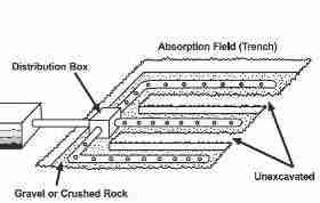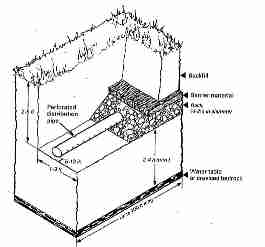 Septic Tank & Drainfield Construction Health Hazards
Septic Tank & Drainfield Construction Health Hazards
Soil & bacterial hazards when excavating sewage-contaminated soils
- POST a QUESTION or COMMENT about septic drainfield or soakaway bed size or capacity requirements & design
This article
InspectAPedia tolerates no conflicts of interest. We have no relationship with advertisers, products, or services discussed at this website.
- Daniel Friedman, Publisher/Editor/Author - See WHO ARE WE?
Septic Tank & Drainfield Construction Health-Safety Warnings
 Health Hazards from Septic System Construction
Health Hazards from Septic System Construction
Watch out: dust from septic system excacation can be dangerous, even fatal!
Besides the obvious hazards associated with excavating any hole in the ground to install a septic tank, drywell, cesspool, or sewer/septic pipe line (falling in), there are may be serious health hazards from sewage pathogens in soil dirt and other debris that are stirred enough to become airborne during excavation and installation of septic tanks and related equipment.
Bacteria in sewage include pathogens that can cause typhoid, cholera, gastroenteritis, or even pneumonia and sepsis.
Such airborne sewage pathogen hazards are more-likely to be present when excavating to investigate, repair, or replace an existing septic system as there will already have been sewage and sewage effluent discharge into the soils being disturbed.
The editor [DF] reports on an interview with a now-retired septic system contractor who worked installing and repairing septic systems in New York State's Hudson Valley. Over the course of decades of septic excavation work the contractor, who usually operated the excavating equipment himself, was exposed to sewage-contaminated airborne dust without ever giving it a thought.
The contractor developed infectious pneumonia, and after eight months of walking pneumonia that was undiagnosed, he was hospitalized at the Castle Point VA Hospital. The contractor said he never realized just how sick he was until becoming suddenly extremely ill, hospitalized, and diagnosed with sepsis.
The septic contractor/excavator was given a 13% chance of survival. That was worse even than the average 30-day sepsis mortality rate of about 24% and 90-day sepsis mortality of about 32%.
Fortunately the contractor, treated by the V.A. at Castle Point, and he recovered to give us this warning.
Sepsis Mortality & Septic System Construction Hazards Research
- SEWAGE CONTAMINATION in BUILDINGS
- SEWAGE PATHOGENS in SEPTIC SLUDGE
- Australia, INFECTION RISKS from WORK WITH SEWAGE [PDF] Australia, Government of Queensland, - retrieved 2022/02/22 original source: https://www.worksafe.qld.gov.au/safety-and-prevention/hazards/hazardous-exposures/biological-hazards/infection-risks-from-work-with-sewage
- Bauer, Michael, Herwig Gerlach, Tobias Vogelmann, Franziska Preissing, Julia Stiefel, and Daniel Adam. "Mortality in sepsis and septic shock in Europe, North America and Australia between 2009 and 2019—results from a systematic review and meta-analysis." Critical Care 24, no. 1 (2020): 1-9. - Open Access at https://ccforum.biomedcentral.com/
Excerpt from Results:
Four thousand five hundred records were identified. After title/abstract screening, 783 articles were assessed in full text for eligibility. Of those, 170 studies were included. Average 30-day septic shock mortality was 34.7% (95% CI 32.6–36.9%), and 90-day septic shock mortality was 38.5% (95% CI 35.4–41.5%).
Average 30-day sepsis mortality was 24.4% (95% CI 21.5–27.2%), and 90-day sepsis mortality was 32.2% (95% CI 27.0–37.5%). - Hoghooghi, N., Pippin, J. S., Meyer, B. K., Hodges, J. B., & Bledsoe, B. P. (2021). Frontiers in assessing septic systems vulnerability in coastal Georgia, USA: Modeling approach and management implications. PloS one, 16(8), e0256606. https://doi.org/10.1371/journal.pone.0256606
- Mattioli, M. C., Benedict, K. M., Murphy, J., Kahler, A., Kline, K. E., Longenberger, A., Mitchell, P. K., Watkins, S., Berger, P., Shanks, O. C., Barrett, C. E., Barclay, L., Hall, A. J., Hill, V., & Weltman, A. (2021). Identifying septic pollution exposure routes during a waterborne norovirus outbreak - A new application for human-associated microbial source tracking qPCR. Journal of microbiological methods, 180, 106091. https://doi.org/10.1016/j.mimet.2020.106091
- Petrie B. (2021). A review of combined sewer overflows as a source of wastewater-derived emerging contaminants in the environment and their management. Environmental science and pollution research international, 28(25), 32095–32110. Advance online publication. https://doi.org/10.1007/s11356-021-14103-1 NLM
- Reneau, R. B., Jr, Pettry, D. E., Shanholtz, M. I., Graham, S. A., Jr, & Weston, C. W. (1977). DISTRIBUTION of TOTAL and FECAL COLIFORM organisms from septic effluent in selected coastal plain soils. Public health reports (Washington, D.C. : 1974), 92(3), 251–259.
- Rothenberg, S. E., Furrer, J. M., Ingram, L. A., Ashford-Carroll, T. S., Foster, S. A., Hystad, P., Hynes, D. M., Navab-Daneshmand, T., Branscum, A. J., & Kruearat, P. (2023). Sanitary sewage overflows, boil water advisories, and emergency room and urgent care visits for gastrointestinal illness: a case-crossover study in South Carolina, USA, 2013-2017. [PDF] Journal of exposure science & environmental epidemiology, 33(1), 102–110. https://doi.org/10.1038/s41370-022-00498-7
- Sadiqi, Shahida, Muhammad Hamza, Farooq Ali, Sadia Alam, Qismat Shakeela, Shehzad Ahmed, Asma Ayaz et al. "Molecular characterization of bacterial isolates from soil samples and evaluation of their antibacterial potential against MDRS [PDF] Molecules 27, no. 19 (2022): 6281.
- Sainath, C., and Khazi Mudabbir Ahmed. OCCUPATIONAL HEALTH HAZARDS IN SEWAGE AND SANITARY WORKERS [PDF] Indian Journal of Basic and Applied Medical Research 3, no. 4 (2014): 31-5.
Abstract excerpt:
These health hazards include exposure to harmful gases such as methane and hydrogen sulfide, cardiovascular degeneration, musculoskeletal disorders like osteoarthritic changes and intervertebral disc herniation, infections like hepatitis, leptospirosis and helicobacter, skin problems, respiratory system problems and altered pulmonary function parameters. - Tiwari, Rajnarayan R. "Occupational health hazards in sewage and sanitary workers." Indian journal of occupational and environmental medicine 12, no. 3 (2008): 112.
- WA DOH, BASIC PRINCIPLES of ONSITE SEWAGE [PDF] (1992) Washington State Department of Health, Office of Water, Washington D.C. USA
Also including as
APPENDIX A: WHY DO COARSE SOILS HAVE LARGER PORE SIZE & LESS SURFACE AREA? & WHY DO FINER SOILS HAVE SMALLER PORE SIZE & MORE SURFACE AREA
and
Cogger, Craig G., APPENDIX B: SEPTIC SYSETEM WASTE TREATMENT in SOIL, (1987) Washington State University Cooperatie Extension, EB1475
- [5] Alaska, INSTALLERS MANUAL FOR CONVENTIONAL ONSITE DOMESTIC WASTEWATER TREATMENT AND DISPOSAL SYSTEMS [PDF] Department of Environmental Conservation, Division of Environmental Health Drinking Water and Domestic Wastewater Program, Alaska Department of Environmental Conservation, 1 Aug 2000, Anchorage Offices, 555 Coredova, Anchorage AK 99501, Tel: 907-269-7500. retrieved 17 July 2012, original source: http://dec.alaska.gov/water/wwdp/onsite/pdf/Certified_Installer%27s_Manual.pdf
Notice: [Quoting]
This document contains information regarding the installation of onsite sewer systems for single-family and duplex residences. It must be used by Certified Installers and homeowners who are subject to 18 AAC 72.
Additional requirements are included in 18 AAC 72. If there is a conflict between the provisions of this manual and 18 AAC 72, 18 AAC 80, or other state regulations, the regulations language controls. AEDC offices. - Wang, L., Hu, Z., Yin, H., Bradford, S. A., Luo, J., & Hou, D. (2022). Aging of colloidal contaminants and pathogens in the soil environment: Implications for nanoplastic and COVID-19 risk mitigation. Soil use and management, 10.1111/sum.12849. Advance online publication. https://doi.org/10.1111/sum.12849
...
Continue reading at SEWAGE CONTAMINATION in BUILDINGS or select a topic from the closely-related articles below, or see the complete ARTICLE INDEX.
Or see these
Recommended Articles
- BACTERIA TEST GUIDE
- CRAWL SPACE SEWAGE CLEANUP
- GARDENS NEAR SEPTICS
- SEPTIC DESIGN for FLOOD DAMAGE RESISTANCE
- SEPTIC / SEWAGE SOIL CONTAMINATION HAZARDS
- SEPTIC & SEWAGE TREATMENT CODES & REFERENCES
- SEPTIC DRAINFIELD INSPECTION & TEST - home
- SEPTIC TANKS - home
- SEWAGE CONTAMINATION in BUILDINGS
- SEWAGE NITROGEN CONTAMINANTS - a second important type of septic effluent contamination.
- SEWAGE PATHOGENS in SEPTIC SLUDGE - pathogens and other contaminants in residential sewage
- SWIMMING WATER TESTS - for sewage pathogens
Suggested citation for this web page
SEPTIC TANK / FIELD INSTALLATION HEALTH HAZARDS at InspectApedia.com - online encyclopedia of building & environmental inspection, testing, diagnosis, repair, & problem prevention advice.
Or see this
INDEX to RELATED ARTICLES: ARTICLE INDEX to SEPTIC DRAINFIELDS & DBOXES
Or use the SEARCH BOX found below to Ask a Question or Search InspectApedia
Ask a Question or Search InspectApedia
Questions & answers or comments about septic drainfield or soakaway bed size or capacity requirements & design.
Try the search box just below, or if you prefer, post a question or comment in the Comments box below and we will respond promptly.
Search the InspectApedia website
Note: appearance of your Comment below may be delayed: if your comment contains an image, photograph, web link, or text that looks to the software as if it might be a web link, your posting will appear after it has been approved by a moderator. Apologies for the delay.
Only one image can be added per comment but you can post as many comments, and therefore images, as you like.
You will not receive a notification when a response to your question has been posted.
Please bookmark this page to make it easy for you to check back for our response.
IF above you see "Comment Form is loading comments..." then COMMENT BOX - countable.ca / bawkbox.com IS NOT WORKING.
In any case you are welcome to send an email directly to us at InspectApedia.com at editor@inspectApedia.com
We'll reply to you directly. Please help us help you by noting, in your email, the URL of the InspectApedia page where you wanted to comment.
Citations & References
In addition to any citations in the article above, a full list is available on request.
- [1] US EPA ONSITE WASTEWATER TREATMENT SYSTEMS MANUAL [online copy, free] Top Reference: US EPA's Design Manual for Onsite Wastewater Treatment and Disposal, 1980, available from the US EPA, the US GPO Superintendent of Documents (Pueblo CO), and from the National Small Flows Clearinghouse. Original source http://www.epa.gov/ORD/NRMRL/Pubs/625R00008/625R00008.htm Onsite wastewater treatment and disposal systems, Richard J Otis, published by the US EPA. U.S. Environmental Protection Agency, Office of Water Program Operations; Office of Research and Development, Municipal Environmental Research Laboratory; (1980)
- [3] "Manual of Policy, Procedures, and Guidelines for Onsite Sewage Systems," Ontario Reg. 374/81, Part VII of the Environmental Protection Act (Canada), ISBN 0-7743-7303-2, Ministry of the Environment,135 St. Clair Ave. West, Toronto Ontario M4V 1P5 Canada $24. CDN.
- [4] Manual of Septic Tank Practice, US Public Health Service's 1959.
- [7] CNMI, SOIL PERCOLATION TEST MANUAL [PDF] CNMI Division of Environmental Quality, PO Box 501304, Saipan, MP 96950. The CNMI Division of Environmental Quality, Gualo Rai, Saipan provides an excellent English Language manual guide for soil percolation testing. Original source: www.deq.gov.mp/artdoc/Sec6art108ID255.pdf
- NYS DOH, RESIDENTIAL ONSITE WASTEWATER TREATMENT SYSTEMS HANDBOOK [PDF] (2012) - original source: http://www.ongov.net/health/env/documents/DesignHandbook10_24_2
- [8] OR, SOIL TEST PIT PREPARATION FOR ONSITE SEWAGE EVALUATIONS [PDF] (fact sheet) State of Oregon Department of Environmental Quality, Portland OR, 800 452-4011. PDF document. Original source deq.state.or.us/wq/pubs/factsheets/onsite/testpitprep.pdf
- [19] USDA SEPTIC TANK / Soil-Absorption Systems: How to Operate & Maintain [PDF] Equipment Tips, U.S. Department of Agriculture, 8271 1302, 7100 Engineering, 2300 Recreation, September 1982, web search 08/28/2010, original source: http://www.fs.fed.us/t-d/pubs/pdfimage/82711302.pdf.
- In addition to citations & references found in this article, see the research citations given at the end of the related articles found at our suggested
CONTINUE READING or RECOMMENDED ARTICLES.
- Carson, Dunlop & Associates Ltd., 120 Carlton Street Suite 407, Toronto ON M5A 4K2. Tel: (416) 964-9415 1-800-268-7070 Email: info@carsondunlop.com. Alan Carson is a past president of ASHI, the American Society of Home Inspectors.
Thanks to Alan Carson and Bob Dunlop, for permission for InspectAPedia to use text excerpts from The HOME REFERENCE BOOK - the Encyclopedia of Homes and to use illustrations from The ILLUSTRATED HOME .
Carson Dunlop Associates provides extensive home inspection education and report writing material. In gratitude we provide links to tsome Carson Dunlop Associates products and services.

